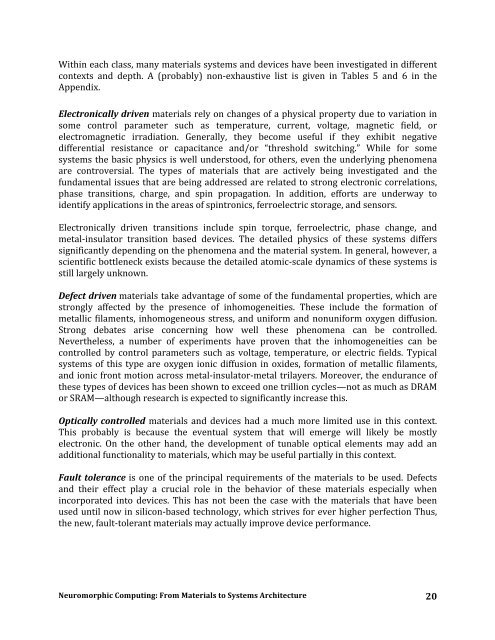Neuromorphic Computing From Materials to Systems Architecture
Neuromorphic-Computing-Report_FNLBLP
Neuromorphic-Computing-Report_FNLBLP
Create successful ePaper yourself
Turn your PDF publications into a flip-book with our unique Google optimized e-Paper software.
Within each class, many materials systems and devices have been investigated in different <br />
contexts and depth. A (probably) non-‐‐exhaustive list is given in Tables 5 and 6 in the <br />
Appendix. <br />
Electronically driven materials rely on changes of a physical property due <strong>to</strong> variation in <br />
some control parameter such as temperature, current, voltage, magnetic field, or <br />
electromagnetic irradiation. Generally, they become useful if they exhibit negative <br />
differential resistance or capacitance and/or “threshold switching.” While for some <br />
systems the basic physics is well unders<strong>to</strong>od, for others, even the underlying phenomena <br />
are controversial. The types of materials that are actively being investigated and the <br />
fundamental issues that are being addressed are related <strong>to</strong> strong electronic correlations, <br />
phase transitions, charge, and spin propagation. In addition, efforts are underway <strong>to</strong> <br />
identify applications in the areas of spintronics, ferroelectric s<strong>to</strong>rage, and sensors. <br />
Electronically driven transitions include spin <strong>to</strong>rque, ferroelectric, phase change, and <br />
metal-‐‐insula<strong>to</strong>r transition based devices. The detailed physics of these systems differs <br />
significantly depending on the phenomena and the material system. In general, however, a <br />
scientific bottleneck exists because the detailed a<strong>to</strong>mic-‐‐scale dynamics of these systems is <br />
still largely unknown. <br />
Defect driven materials take advantage of some of the fundamental properties, which are <br />
strongly affected by the presence of inhomogeneities. These include the formation of <br />
metallic filaments, inhomogeneous stress, and uniform and nonuniform oxygen diffusion. <br />
Strong debates arise concerning how well these phenomena can be controlled. <br />
Nevertheless, a number of experiments have proven that the inhomogeneities can be <br />
controlled by control parameters such as voltage, temperature, or electric fields. Typical <br />
systems of this type are oxygen ionic diffusion in oxides, formation of metallic filaments, <br />
and ionic front motion across metal-‐‐insula<strong>to</strong>r-‐‐metal trilayers. Moreover, the endurance of <br />
these types of devices has been shown <strong>to</strong> exceed one trillion cycles—not as much as DRAM <br />
or SRAM—although research is expected <strong>to</strong> significantly increase this. <br />
Optically controlled materials and devices had a much more limited use in this context. <br />
This probably is because the eventual system that will emerge will likely be mostly <br />
electronic. On the other hand, the development of tunable optical elements may add an <br />
additional functionality <strong>to</strong> materials, which may be useful partially in this context. <br />
Fault <strong>to</strong>lerance is one of the principal requirements of the materials <strong>to</strong> be used. Defects <br />
and their effect play a crucial role in the behavior of these materials especially when <br />
incorporated in<strong>to</strong> devices. This has not been the case with the materials that have been <br />
used until now in silicon-‐‐based technology, which strives for ever higher perfection Thus, <br />
the new, fault-‐‐<strong>to</strong>lerant materials may actually improve device performance. <br />
<strong>Neuromorphic</strong> <strong>Computing</strong>: <strong>From</strong> <strong>Materials</strong> <strong>to</strong> <strong>Systems</strong> <strong>Architecture</strong> <br />
20


